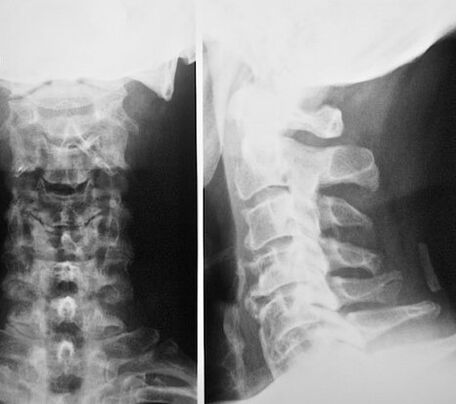Among all the diseases known to humanity, the diseases of the maintenance apparatus may be most often. There is unlikely to have a person over 40 who has not experienced problems with the spine, not complaining of joint pain or muscles. The reason for this phenomenon is most often converted to a sedentary lifestyle when, with age, with a decrease in motor activity, salts and other harmful substances are deposited in the joints that impair the functionality of the bone system. It is generally accepted that diseases of the maintenance and motor plow occur only in adulthood people, but in recent years young people have often been diagnosed with this type of disease. It is quite difficult to treat such diseases, especially when degenerative - dystrophic changes affecting adjacent cartilage, bones and nerve tissues appear in the tissues. A number of diseases that disrupt the structure of the bone system is given a special place of such a disease as cervical osteochondrosis, which is considered to be the most common disease of our time and is found not only in adults but also in young people under 35 years of age.
Osteochondrosis of the cervical region is a progressive disease, so the untimely treatment and later seeking a doctor - spina can lead to human damage. What are these insidious diseases? What are the symptoms of cervical osteochondrosis and how to deal with this disease?
Cervical osteochondrosis is a progressive disease characterized by degenerative - dystrophic changes in the intervertebral discs that are served deformities, change their structure that causes a number of pronounced symptoms. At risk for the development of osteochondrosis of the cervical region are people who lead a sedentary lifestyle or whose professional activity is related to the body in one position for a long time. With regard to the incidence of osteochondrosis, damage to the cervical spine is ranked second after lumbosacral osteochondrosis. The peculiarity and complexity of the disease is that the lesion of the cervical region almost always affects the nerve roots of the spinal nerves and the intervertebral discs, which resulted in large and small vessels defeated by the blood supply to the brain.
The cervical compartment has a complex structure and consists of 7 vertebrae, each of which performs a number of functions: it supports the head, rotates, bends the neck and other important functions. There are intervertebral discs between the vertebrae that make the spine flexible and durable, and the intervertebral discs themselves consist of fibrous rings inside which there are pulse nuclei. The cervical vertebrae fit close to each other, which is why even minor physical activity can cause their displacement, which in turn causes the blood vessels and nerves to squeeze. In the cervical spine are the spinal arteries that are responsible for the blood supply to the brain. When compressing them, the blood supply is disturbed, the brain does not receive enough vital substances, which undoubtedly leads to its damage and development of a number of complications, which can lead to damage to the patient or even death.
Despite the spread of this disease and the achievements in modern medicine, the pathogenesis of osteochondrosis of the cervical spine has not been fully studied. It is known that the disease can develop against the background of metabolic impaired processes in the cervical spine, which over time leads to a change in the structure of the intervertebral discs and the bodies of the vertebrae. Among other species of osteochondrosis, the cervix is the most dangerous because during its development there is a compression of the nerve roots of the spinal cord and blood vessels, which undoubtedly leads to a disruption of the blood supply to the brain cells. In the pathogenesis of the disease, doctors distinguish several provocative factors that can lead to the development of the disease.
In addition to factors that can lead to the development of cervical osteochondrosis, experts differentiate people who are at risk for the development of this disease.
The cause of the development of cervical osteochondrosis may be other causes, but in any case the disease should be treated at its first signs.
How to recognize osteochondrosis of the cervical region and what are its signs?
Clinical signs of cervical osteochondrosis osteochondrosis of the cervical spine develops slowly. The symptoms of the disease depend on the degree and number of the damaged vertebrae and the pinching of the nerve endings. The main symptom of the disease is pain with varying intensity in the spine, neck, lower back, which are given to other organs. Only a doctor can diagnose "osteochondrosis of the cervical part" after the results of the study, since the variety of the clinic of the disease often looks like other pathologies, but anyone can suspect the disease. 
Clinical signs of osteochondrosis of the cervical region, expressed and occur when the disease develops and progresses. Doctors involved in the treatment of this disease distinguish several cervical osteochondrosis syndromes, each of which has its own characteristics and manifests itself depending on the damaged nerve spine.
Cervical osteochondrosis - Symptoms and treatment directly depend on the damaged nerve spine. The number of cervical roots is 8 and the cervical vertebrae is 7. Each cervical nerve is above the vertebrae and with damage has its own symptoms.
If there was a defeat of the first and second cervical vertebra (CI-II), then the sensitivity of the back of the head would be disturbed, which attracts pain in the parietal and dorsal region.
The lesion of nerve completion (C3) is extremely rare, but when it is damaged, the patient experiences tingling of the neck in the area where pinching occurs. The speed, the sensitivity of the tongue is also disturbed.
The C4 lesion of the nerve spine causes pain and numbness in the collar or shoulder. Respiratory disorders are noted heartache.
If the spinal segment of the 5th department is disturbed, then the patient will feel the pain that spreads on the shoulder, the outer surface of the shoulder, the sensitivity of the upper and lower limbs is also disturbed.
Pressing the roots of C6 and C7 the most common phenomena among patients. Patients experience pain in the neck, blade, forearm, back, lower back, sensitivity of the arms, fingers are disturbed.
When the nerve spine is affected, then the pain will spread to the neck, back, elbow and give it to the lower limbs. The tingling of the small toes on the hands and feet is noted, the sensitivity of the skin is virtually absent. The legs and arms of the hands acquire a bluish tinge due to impaired blood circulation.
In addition to pain syndromes, a patient with cervical osteochondrosis also complains of other diseases that are described above in the signs of the disease: impaired vision, dizziness, seizures, etc.
It is necessary to perform and conduct physiotherapy exercises only after consulting a doctor. In addition, movement should discuss any performance with a specialist, as the improper position of the neck or limbs can further damage the health and worsen treatment. Consider a few safe exercises that can and should be performed for patients with cervical osteochondrosis.
Physical physical education is quite effective in the treatment of cervical osteochondrosis, but all exercises should be performed regularly and properly. Of course, the condition is not improved by the first classes, so you have to be patient.
Traditional medicine also shows its effectiveness in the treatment of cervical osteochondrosis, which has collected a large number of recipes in its arsenal from decades to hundreds of years that will help reduce the symptoms of the disease. The treatment of osteochondrosis with folk remedies is to use vegetable and animal products for external or internal use.
Recipe 1. Cervical osteochondrosis honey. You will need 1 - 2 teaspoons of natural honey, 2 mummy tablets. Honey and mummy should be heated, placed on a warm scarf and attached to the neck overnight. Honey has a pronounced anti -inflammatory, biostimulatory property, so it can perfectly supplement the treatment of this disease.
Recipe 2. Celery of osteochondrosis. 4 - 5 grams of celery should be poured with 1 liter of boiling water, insist for 2 - 4 hours, strain and take 1 large spoon 3 times a day.
Recipe 3. Decoction of chamomile and olive oil. You will need 30 grams of chamomile flowers, 0, 5 l olive oil. Chamomile flowers should be poured into the oil, placed over low heat, boiled and allowed to cool. You need to insist the decoction for 2 days, then judge it through the full and rub the diseased areas with the oil obtained. Other herbs can be used along with chamomile: Salandin, Calendula, St. John. If there is no olive oil at hand, then you can take a sunflower.
There are other remedies for traditional medicine that help relieve the symptoms of cervical osteochondrosis. However, it is important to remember that such treatment is effective only at the beginning of the development of the disease and can only be used with complex treatment with traditional methods.
Prevention of osteochondrosis of the neck is an active lifestyle. In cases where there is room for the development of this disease, it is necessary to visit a doctor - orthopedic periodically. No less important is the occupation of food that should be useful, rich in vitamins, minerals and other nutrients. Prevention or adjustment of excess weight, as well as regular exercise, reduce the risk of developing cervical osteochondrosis several times.


















































